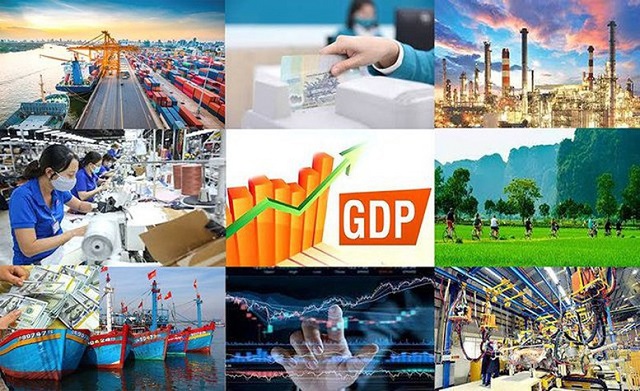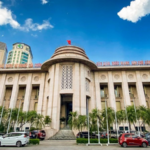
The government proposes five key solutions to achieve an economic growth rate of 8.3-8.5% in 2025
|
Resolution 226 sets out: The government aims to continue prioritizing growth promotion while maintaining macroeconomic stability, curbing inflation, and ensuring the major balances of the economy, including budget deficit, public debt, government debt, and national foreign debt, within the limits permitted by the National Assembly. The target is to achieve an economic growth rate of 8.3-8.5% in 2025, with the average consumer price index (CPI) increase kept below 4.5%. The resolution also aims to further improve and enhance the material and spiritual lives of the people.
To achieve the 2025 growth target, the resolution outlines the following key tasks and solutions:
Promoting growth through social investment
The government requests that ministries, agencies, and localities propose feasible and effective solutions to attract and mobilize social investment in line with set targets, striving for higher achievements when favorable conditions arise. In the last six months of the year, the focus should be on executing and disbursing 100% of the planned state budget investment capital for 2025 assigned by the Prime Minister, as well as the entire investment capital from the increased revenue and cost savings of the state budget in 2024, which is expected to be disbursed in 2025. This includes approximately VND 1.5 million billion in private investment, FDI attraction of over USD 18 billion and FDI realization of about USD 16 billion, and investment realization from other sources of about VND 165 thousand billion.
The State Bank of Vietnam is tasked with closely monitoring and proactively, flexibly, and effectively managing monetary policy tools, in coordination with fiscal policy and other macroeconomic policies. It should ensure stability in the monetary and foreign exchange markets, in line with market conditions. The State Bank will also instruct credit institutions to continue reducing costs and strive to lower lending interest rates to support the production and business activities of enterprises and the livelihoods of the people, while enhancing credit quality and limiting the formation of bad debts. It will proactively adjust the 2025 credit growth target, making it public, transparent, and in line with inflation control targets, to drive growth of 8.3-8.5% and meet the economy’s capital needs. Credit institutions will be guided to channel credit into priority production and business sectors, traditional growth drivers of the economy (investment, exports, and consumption), and new drivers (including science and technology, innovation, digital transformation, digital economy, green economy, circular economy, and social housing…). The State Bank will also prepare monetary policies for the last months of 2025 and 2026 and report to the Government before August 20, 2025.
The Ministry of Finance will implement an appropriately expanded fiscal policy with a focus on key areas, enhancing revenue management, and expanding the revenue base, striving to increase the state budget revenue in 2025 by at least 25% compared to the estimate (based on developments and strive to increase revenue higher than 25%). It will also strictly save on regular expenses, saving an additional 10% of the regular expense estimate for the last seven months of 2025 to support social security and the construction of boarding and semi-boarding schools for students in remote, border, and island areas. The ministry will take advantage of the public debt and budget deficit room to mobilize additional investment resources for key projects in transportation, digital infrastructure, healthcare, and education. Fiscal policies for the last months of 2025 and 2026 will be prepared and reported to the Government before August 20, 2025.
The Ministry of Industry and Trade, the Ministry of Finance, and corporations and enterprises should be ready with plans and scenarios to respond to any arising situations, increase hydropower exploitation during the rainy season, ensure energy balance and domestic oil and gas supply, and ensure energy security to meet production and business needs. They should also prepare plans for power supply and regulation to ensure electricity supply during the hot season and complete procedures for investment, implementation, and operation of large power generation and transmission projects. It is necessary to immediately adjust certain points in the decrees on the mechanism for direct power purchase and sale between renewable energy generators and large consumers, and on mechanisms and policies to encourage the development of rooftop solar power for self-consumption.
Regarding the promotion of public investment disbursement, the government requests that ministries, agencies, and localities build plans, schedules, and monthly disbursement targets for each investor, identify and promptly address any difficulties and obstacles in projects, and proactively manage capital plans to ensure sufficient capital for projects with implementation and disbursement capabilities. It is crucial to ensure the progress of key national infrastructure projects, fully disburse the allocated capital, and strive to complete the North-South Expressway, 3,000 km of highways, and 1,700 km of coastal roads in 2025. Concrete plans should be in place to prepare for the groundbreaking and initiation of the site clearance and resettlement projects for the Lao Cai-Hanoi-Haiphong railway and the high-speed North-South railway, as well as projects serving the APEC 2027 conference…
The Ministry of Ethnic Affairs and Religion, the Ministry of Agriculture and Environment, the Ministry of Education, and other ministries, agencies, and localities will accelerate the implementation of national target programs. They will complete the goal of eliminating temporary and dilapidated houses for people with revolutionary merits, relatives, and families of martyrs before July 27, 2025, and strive to basically eliminate temporary and dilapidated houses nationwide before August 31, 2025. They will also construct boarding and semi-boarding schools for secondary students in remote, border, and island areas. The Ministry of Education will take the lead in inspecting educational institutions, kindergartens, preschools, and schools to ensure completion of construction, renovation, and repair work before the 2025-2026 school year opening. There must be no shortage of schools or classrooms on the first day of school.
In August 2025, the Ministry of Agriculture and Environment will submit to the government for issuance a resolution on mechanisms and policies to remove difficulties and obstacles in the implementation of the Law on Geology and Minerals 2024, including mechanisms to address difficulties related to the exploitation of construction minerals to provide for key transport infrastructure projects, important national projects, and other public investment projects of ministries, sectors, and localities.
Ministries, agencies, and localities will promote decentralization and delegation of power, administrative procedure reform, and national digital transformation, as well as encourage private investment and effectively handle difficult and stagnant issues and projects. The Ministry of Construction, the Ministry of Agriculture and Environment, and other ministries, agencies, and localities will urgently review issues related to land and the real estate market to propose amendments and supplements to the Land Law, the Law on Real Estate Business, and the Housing Law. They will also promptly guide and remove difficulties and obstacles in the implementation of Resolution 201/2025/QH15 on the pilot mechanism and policy for the development of social housing, set a roadmap to complete at least 100,000 social housing units in 2025, and promote the sustainable and healthy development of the real estate market.
The Ministry of Finance and other ministries, agencies, and localities will have concrete plans to promote the role of state capital owners and direct state economic groups and corporations to play a leading role, renew governance, and improve production and business efficiency, striving for a production or revenue growth rate of over 10% in 2025.
Promoting consumption and harnessing the domestic market
The government assigns the Ministry of Industry and Trade to implement trade promotion activities and goods distribution through digital platforms, striving for e-commerce growth of over 25% for the year. It will also support the provision of market information and legal advice to businesses to boost the domestic market, promote the “Vietnamese People Give Priority to Using Vietnamese Goods” movement, and develop distribution systems for “The Finest Vietnamese Goods” and “Vietnamese Goods Pride”. These efforts will contribute to enhancing consumers’ access to domestically produced goods. There should be initiatives to create trends and campaigns to encourage the consumption of goods produced in Vietnam.
The Ministry of Industry and Trade, the Ministry of Finance, the Ministry of Public Security, and other ministries, agencies, and localities will develop concrete plans and regularly and effectively implement measures to combat smuggling, trade fraud, counterfeit and substandard goods, and intellectual property infringement…
Ministries, agencies, and localities will closely monitor price and market movements, regularly update inflation scenarios, and propose appropriate price management solutions to prevent shortages, supply disruptions, and sudden price increases. They will also strictly handle violations of the law on prices, hoarding, profiteering, and price manipulation.
The Ministry of Culture, Sports and Tourism, and localities will promote tourism stimulation and develop diverse and high-quality tourism products for each tourist season and key destinations, effectively exploiting international and domestic tourism seasons and increasing the experience and average spending of tourists. The target is to attract at least 25 million international visitors and 150 million domestic tourists in the year. It is also crucial to strengthen inspections, manage the market, accommodation and catering services, and ensure food safety and hygiene, especially in key tourist areas. Additionally, it is essential to enhance linkages in tourism development and combine tourism with the consumption of OCOP products and local specialties.
The Ministry of Public Security and the Ministry of Foreign Affairs, according to their functions and tasks, will take the lead, in coordination with the Ministry of Culture, Sports and Tourism, in building convenient and flexible visa policies for tourists and improving visa application procedures for tourists entering Vietnam.
Promoting exports and harmonious trade development with countries
The Ministry of Industry and Trade will take the lead, in coordination with ministries, agencies, and localities, in continuing to proactively and actively negotiate a reciprocal trade agreement with the United States as directed by the competent authorities, ensuring the balance of interests of both sides.
It is essential to effectively utilize the signed FTAs. Negotiations should be promptly initiated to sign new FTAs, especially with the Middle East, India, Africa, and Latin America, and to upgrade the ASEAN Trade in Goods Agreement. Proactive trade promotion solutions should be implemented to support businesses in accessing and boosting exports for key industries, priority markets, niche markets, and potential markets, taking full advantage of the peak consumption season in major markets towards the end of the year.
The Ministry of Industry and Trade, the Ministry of Agriculture and Environment, the Ministry of Health, and the Ministry of Finance, according to their functions and tasks, will focus on handling difficulties and obstacles in import and export regulations, especially long-standing proposals from businesses and associations, and promptly review and remove unnecessary customs and specialized inspection regulations that overlap and duplicate. They will also facilitate the transition of export enterprises to the domestic market, accelerate customs clearance, reduce logistics costs, and create favorable conditions for enterprises, giving priority to the clearance of agricultural and forestry products, especially those that are in the main harvest season and perishable.
Promoting new growth drivers
Ministries, agencies, and localities will continue to vigorously and effectively implement the “quadruple pillar” resolutions of the Politburo (Resolutions No. 57-NQ/TW, 59-NQ/TW, 66-NQ/TW, and 68-NQ/TW), as well as new development drivers, including science and technology, innovation, digital transformation, and the development of high-quality human resources, and take advantage of the benefits of deep international integration.
It is crucial to promote the implementation of solutions to drive the development of the digital economy, green economy, circular economy, new business models, and emerging sectors such as artificial intelligence (AI), big data, cloud computing, cultural industries, and entertainment industries…
Additionally, the Ministry of Health and the Ministry of Education will urgently complete the Politburo’s resolutions on breakthroughs in people’s healthcare and education modernization to meet the country’s development requirements in the new era.
The Ministry of Finance will finalize the reports to the Politburo on the development of the state economic sector and the attraction of new-generation FDI, as well as implement measures to upgrade the stock market from a frontier market to an emerging market, closely coordinate with relevant ministries and agencies to promptly address difficulties and obstacles to meet the upgrade criteria, and develop the capital market towards international practices. It will also coordinate with ministries, agencies, and localities to implement the National Assembly’s resolution on the international financial center, the construction of a free trade area, and the development of border economic zones in key economic localities. The ministry will proactively deploy solutions to attract and effectively utilize indirect investment capital in Vietnam, enhance the economy’s ability to absorb indirect investment capital, and review the National Master Plan to maximize the potential and advantages of the new development space after the merger of localities.
The Ministry of Public Security will take the lead, in coordination with the Ministry of Agriculture and Environment, the Ministry of Industry and Trade, the Ministry of Construction, Hanoi, Ho Chi Minh City, and other major cities, in building a roadmap and plan to implement the Prime Minister’s Directive No. 20/CT-TTg dated July 12, 2025, on urgent tasks and solutions to resolutely prevent and address environmental pollution, ensuring practicality, effectiveness, and suitability with the socio-economic development conditions of each locality. It is also necessary to study and have supportive policies and incentives for businesses and individuals involved in the development of green transportation.
Ensuring the smooth and effective operation of the two-level local government
Ministries, agencies, and localities, according to their functions and tasks, will continue to review and implement the arrangement and completion of the organizational apparatus of the political system in 2025 in accordance with Resolution No. 18-NQ/TW and the conclusions of the Central Committee, the Politburo, and the Secretariat, ensuring the operation of the two-level local government in a smooth, uniform, effective, and powerful manner. They will also carefully and thoroughly prepare for the effective organization of party congresses at all levels towards the 14th National Party Congress.
It is important to closely monitor the operation of the two-level local government and the implementation of the 28 decrees on decentralization and delegation of power to promptly address any difficulties and obstacles that arise during the implementation process.
The Ministry of Science and Technology, the Ministry of Public Security, and the Ministry of Home Affairs will effectively implement tasks for digital transformation to serve the operation of the two-level local government model.
It is crucial to build a contingent of grassroots officials with good morals, qualifications, proximity to the people, and problem-solving capabilities at the grassroots level.
The Ministry of Finance and other ministries, agencies, and localities will arrange sufficient and timely funds to pay for policies and regimes according to Decree No. 178/2024/ND-CP and Decree No. 67/2025/ND-CP and tasks to serve the arrangement of administrative units and the implementation of the two-level local government. They will also promptly and fully resolve policies and regimes for officials, public employees, and workers in the arrangement of the apparatus, especially those who have been decided to retire.
Ministries, sectors, and localities will urgently develop growth scenarios and solutions for the last months of the year.
Regarding the GRDP growth target, localities will direct specialized agencies to coordinate closely with the statistics sector to review the estimated GRDP for the first six months, the ability to mobilize resources, growth drivers, and development space in the last six months. They will promptly review and build GRDP growth scenarios by economic sector and net product tax deduction by industry for the remaining quarters of the year, along with solutions to strive to achieve and exceed the targets set out in Appendix III of this Resolution.
Ministries, agencies, and localities will send the Ministry of Finance the scenario for implementing the assigned growth target before August 15, 2025, for synthesis and monitoring.
Ministries, agencies, and localities will proactively implement tasks and solutions within their competence and propose mechanisms, policies, tasks, and solutions beyond their competence to the Ministry of Finance for synthesis and reporting to the Government and the Prime Minister to promptly remove difficulties and obstacles, promote growth, and achieve the targets assigned in this Resolution, striving to exceed the targets in favorable conditions.
|
Resolution 226/NQ-CP takes effect from August 5, 2025, replacing Resolution No. 25/NQ-CP dated February 5, 2025, on growth targets for sectors, fields, and localities to ensure the country’s growth rate reaches at least 8% in 2025. |
The CPI for the first seven months is estimated to increase by 3.2-3.3%.
The Ministry of Finance reports that the consumer price index (CPI) for the first seven months of the year is estimated to have increased by 3.2-3.3% compared to the same period last year. This is an appropriate level that supports economic growth, especially as resources are being focused on achieving the highest possible economic expansion. Vietnam’s inflation is being carefully managed within the target range set by the National Assembly and the Government of 4.5-5%, contributing to macroeconomic stability.
The Alluring Appeal of Bank Deposits: What’s Keeping Funds from Venturing Out?
Despite the low savings interest rates, banks continue to attract massive cash inflows. This phenomenon can be attributed to a combination of factors, including a cautious mindset, deep-rooted trust in the banking system, and traditional savings habits, which together create a strong pull for idle funds to remain within the confines of these financial institutions.
“Vietnam’s Central Bank Meets With Commercial Banks to Discuss Interest Rates”
The State Bank of Vietnam (SBV) has instructed credit institutions to follow the directives of the Government, the Prime Minister, and the SBV itself, with a key focus on maintaining stability in deposit interest rates. Institutions are also encouraged to further reduce operating expenses, embrace digital transformation, and be prepared to share a portion of their profits to lower lending rates.
The Bank’s Endeavor to Lower Interest Rates
The Central Bank, in a bid to heed the Government and Prime Minister’s directive on enhancing measures to reduce interest rates, convened a meeting with the credit institution system on August 4, 2025. The primary focus of this gathering was to discuss strategies for stabilizing deposit rates and reducing lending rates.










































